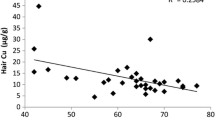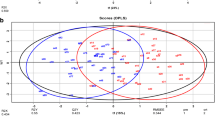Abstract
The remarkable calcification of the basal ganglia and cerebellum has been traditionally called Fahr’s disease, but this nomenclature is criticized for including heterogeneous diseases. To determine the pattern of some biological metals in the hair of patients with Fahr’s disease, we investigated the levels of 24 bioelements in the hair of 28 patients (17 males and 11 females) with Fahr’s disease and compared them with those of three age-, sex-, and living region-matched controls (84 controls in total). Interestingly, we found decreases in the levels of several bioelements [calcium (Ca), copper (Cu), iron (Fe), mercury (Hg), iodine (I), nickel (Ni), phosphate (P), lead (Pb), and selenium (Se)] in the hair of patients. This is in contrast to our previous finding of increases of Cu, Fe, zinc (Zn), and magnesium (Mg) in the cerebrospinal fluid (CSF) of patients. The decreased level of Cu in the hair was the most prominent and pathognomonic, while the increased level of Cu in the CSF had been found to be the most significant in patients. More significant correlations between two bioelements in the hair were recognized in patients than controls. Although Fahr’s disease has been considered to be a heterogenous entity, the significant tendencies of several bioelements in the hair of patients in this study suggest metabolic disorders of bioelements, especially biometals, on the background. Some transporters, especially P transporter such as PiT2, of bioelements will be involved in the different distribution of bioelements in the body of patients.
Similar content being viewed by others
References
Manyam BV (2005) What is and what is not ‘Fahr’s disease’. Parkinson and Related Disord 11:73–80
Geschwind DH, Loginov M, Stern JM (1999) Identification of a locus on chromosome 14q for idiopathic basal ganglia calcification (Fahr disease). Am J Hum Genet 65:764–772
Lemos RR, Oliveira DF, Zatz M et al (2011) Population and computational analysis of the MGEA6 P521A variation as a risk factor for familial idiopathic basal ganglia calcification (Fahr’s disease). J Mol Neurosci 43:333–336
Oliveira JR, Spiteri E, Sobrido MJ et al (2004) Genetic heterogeneity in familial idiopathic basal ganglia calcification (Fahr disease). Neurology 63:2165–2167
Volpato CB, De Grandi A, Buffone E et al (2009) 2q37 as a susceptibility locus for idiopathic basal ganglia calcification (IBGC) in a large South Tyrolean family. J Mol Neurosci 39:346–353
Dai X, Gao Y, Xu Z et al (2010) Identification of a novel genetic locus on chromosome 8p21.1-q11.23 for idiopathic basal ganglia calcification. Am J Med Genet B Neuropsychiatr Genet 7:1305–1310
Wang C, Li Y, Shi L, Ren J et al (2012) Mutations in SLC20A2 link familial idiopathic basal ganglia calcification with phosphate homeostasis. Nat Genet 44:254–256
Kosaka K (1994) Diffuse neurofibrillary tangles with calcification: a new presenile dementia. J Neurol Neurosurg Psychiatry 57:594–596
Shibayama H, Kobayashi H, Nakagawa M et al (1992) Non-Alzheimer non-Pick dementia with Fahr’s syndrome. Clin Neuropathol 11:237–250
Nanda S, Bhatt SP, Pamula J et al (2007) Diffuse neurofibrillary tangles with calcification (DNTC): Kosaka–Shibayama disease in America. Am J Alzheimer’s Disease and Other Dementias 22:535–537
Smeyers-Verbeke J, Michotte Y, Pelsmaeckers J et al (1975) The chemical composition of idiopathic nonarteriosclerotic cerebral calcifications. Neurology 25:48–57
Duckett S, Galle P, Escourolle R et al (1977) Presence of zinc, aluminum, magnesium in striopalledodentate (SPD) calcifications (Fahr’s disease): electron probe study. Acta Neuropathol 38:7–10
Hozumi I, Kohmura A, Kimura A et al (2010) High levels of copper, zinc, iron and magnesium, but not calcium, in the cerebrospinal fluid of patients with Fahr’s disease. Case Rep Neurol 2:46–51
Yasuda H, Yoshida K, Yasuda Y, Tsutsui T (2011) Infantile zinc deficiency: association with autism spectrum disorders. Scientific Reports 1, Article number:129
Ochi A, Ishimura E, Tsujimoto Y, Kakiya R, Tabata T, Mori K, Shoji T, Yasuda H, Nishizawa Y, Inaba M (2011) Trace elements in the hair of hemodialysis patients. Biol Trace Elem Res 143:825–834
Shore D, Henkin RI, Nelson NR et al (1984) Hair and serum copper, zinc, calcium, and magnesium concentrations in Alzheimer-type dementia. Am Geriatr Soc 32:892–895
Forte G, Alimonti A, Violante N et al (2005) Calcium, copper iron, magnesium, silicon and zinc content of hair in Parkinson’s disease. J Trace Elem Med Biol 19:195–201
Yasuda H, Yonashiro T, Yoshida K et al (2005) A mineral imbalance in children with autistic disorders. Biomed Res Trace Elements 16:285–292
Tuschl K, Clayton PT, Gospe SM et al (2012) Syndrome of hepatic cirrhosis, dystonia, polycythemia, and hypermanganesemia caused by mutations in SLC30A10, a manganese transporter in man. Am J Hum Genet 90:1–10
Acknowledgments
We thank Dr. T. Imai of Sapporo Medical University Hospital, Dr. H. Ishida of Izumi Municipal Hospital, Dr. K. Iyoda of Hiroshima City Hospital, Dr. N. Kamisato of Akita Rosai Hospital, Dr. J. Kawata of Shonankamakura General Hospital, Dr. S. Kobayashi of Sapporo Medical University Hospital, Dr. A. Kume of Kume Clinic, Dr. K. Maeda of Shiga Hospital, Dr. Y. Manabe of Okayama Medical Center, Dr. M. Matsuo of Saga University Hospital, Dr. E. Miyashiro of Kaseitamura Hospital, Dr. K. Miyazaki of Shiseikai Daini Hospital, Dr. M. Mori of Jichi Medical University Hospital, Dr. T. Motoshima of Chiba Children’s Hospital, Dr. H. Murai of Iizuka Hospital, Dr. K. Shioya of Miyazaki Higashi Hospital, Dr. K. Nagashima of Public Nanokaichi Hospital, Dr. T. Nishigaki of Osaka Police Hospital, Dr. H. Nishimura of Nishinomiya Kyoritu Neurosurgical Hospital, Dr. H. Nishiura of Isahaya Health Insurance General Hospital, Dr. H. Shimada of Osaka City University Hospital, Dr. N. Suzuki of Tohoku University Hospital, Dr. Y. Taguchi of Toyama University Hospital, Dr. S. Takeshita of Yokohama City University Medical Center, Dr. E. Tsuda of Sapporo Medical University Hospital, Dr. S. Tsuneishi of Medical Welfare Center Kizuna, Dr. T. Uemichi of Kinki Central Hospital, and Dr. M. Yamada of Omori Red Cross Hospital for providing the patient specimens. We also thank Professor H. Hara of Gifu Pharmaceutical University, and Professor M. Sato of Aichi Gakuin University, for their helpful suggestions. This work was supported by a grant from the Ministry of Health, Labour and Welfare of Japan (H23-Nanbyo-Ippan-106 (to IH).
Author information
Authors and Affiliations
Corresponding author
Rights and permissions
About this article
Cite this article
Takagi, M., Ozawa, K., Yasuda, H. et al. Decreased Bioelements Content in the Hair of Patients with Fahr’s Disease (Idiopathic Bilateral Calcification in the Brain). Biol Trace Elem Res 151, 9–13 (2013). https://doi.org/10.1007/s12011-012-9529-z
Received:
Accepted:
Published:
Issue Date:
DOI: https://doi.org/10.1007/s12011-012-9529-z




